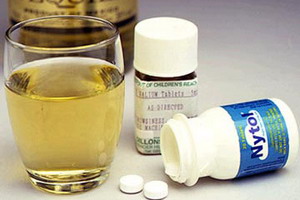 A sedative is a substance that has a depressant action on the central nervous system and resulting in a soothing, relaxation, a reduction in anxiety, drowsiness, slow breathing, staggering, disorders of the judgment and decreased reflexes.
A sedative is a substance that has a depressant action on the central nervous system and resulting in a soothing, relaxation, a reduction in anxiety, drowsiness, slow breathing, staggering, disorders of the judgment and decreased reflexes.
A sedative may also be designated as a tranquilizer, depressant, anxiolytic, overpowering, sleeping pill or sedative-hypnotic. High-dose, most sedatives can cause unconsciousness and death.
Types of sedatives
- Barbiturates
- secobarbital (Seconal)
- pentobarbital (Nembutal)
- amobarbital (Amytal)
- Benzodiazepines
- Bromazepam (Lexomil ®)
- Clonazepam (Rivotril ®)
- Clorazepate (Tranxene ®)
- Chlordiazepoxide (Librium ®, Librax ®)
- Diazepam (Valium ®)
- Clonazepam (Klonopin ®)
- Flunitrazepam (Rohypnol ®)
- Lorazepam (Ativan ®, Temesta ®, Tavor ®)
- Tetrazepam (Myolastan ®)
- Imidazopyridines
- zolpidem (Ambien)
- alpidem
- Pyrazolopyrimidines
- Zaléplon (Sonata)
- Antihistamines
- Diphenhydramine (Benadryl, Sominex)
- dimenhydrinate (Dramamine)
- doxylamine
- antipsychotics atypical
- quetiapine (Seroquel)
- Sedative plants
- Valerian
- Mandrake
- Kava
- Other sedatives
- methaqualone (Sopor, Quaalude)
- ethchlorvynol (Placidyl)
- chloral hydrate (Noctec)
- meprobamate (Miltown)
- glutethimide (Doriden)
- methyprylon (Noludar)
- Gamma-hydroxybutyrate (GHB)
- ethanol (alcoholic beverage)
- diethylether (ether)
- trichloromethane (chloroform)
Therapeutic use
Although sedatives do not relieve the pain, the doctors and nurses to administer frequently to their patients to calm the anxiety caused by acts or procedures painful or anxiety. They can be useful in conjunction with painkillers, to prepare the patient for surgery and are often used prior to anesthesia or any other Act stressful, such as MRI.
They increase the docility and obedience of children or troubled persons.
Patients in the intensive care unit are almost systematically under sedation (unless they are unaware of their condition).
Addiction to sedatives
Taking regular sedatives (even at therapeutic doses) may lead to a dependence or physical or psychological, or both. When a dependent user decreases or stops suddenly consumption, it will show withdrawal symptoms ranging from agitation, insomnia and anxiety to convulsions and death. Psychological as physical, the dependence can be treated.
Diverted and recreational uses
All sedatives can be used abusively, but barbiturates are responsible for the largest number of problems, because a part of the “sur-prescription” of physicians and of the non-medical use or widespread “recreational”. People who have difficulty managing stress, anxiety or lack of sleep are particularly susceptible to abuse and become dependent on sedatives. Heroin users are sometimes in conjunction with their drug or to temporarily replace. Users of stimulants use them to calm excessive agitation. Others make a recreational use to relax and forget their worries.
Barbiturates overdose is a factor in nearly one-third deaths attributed to the drug, including suicide and accidental drug poisoning (accidental deaths occur sometimes when someone subject to confusion due to a sedative takes several times the dose of medication).
In the United States, in 1998, a total of 70 982 appeals to the ingestion of sedatives were recorded by poison centres. 2 310 of them (or 3.2%) proved to be a major toxic problems and 89 (or 0.1%) resulted in death. Always the United States, little about half of those admitted to emergency on non-medical use of sedatives had a prescription for the product, but it had used excessive dose or had consumed it with alcohol or other drugs. Others receive sedatives of their friends who have a lawful order or false prescription.
See also: abuse of barbiturates.
Sedatives, especially GHB, are sometimes administered by some rapists, especially when “acquaintance rape” (acquaintance (“date”) rape in English).
Sedatives and alcohol
Sedatives and alcohol are sometimes combined imprudently or recreational purpose. Since alcohol is a depressant of the central nervous system, both substances are mutually reinforcing and this association may be fatal. In 1975, Karen Ann Quinlan fell into a coma after swallowing the alcohol and tranquilizers in an evening. His case triggered a global ethical debate about the judgment of equipment maintenance of vital functions.
Simili-Drogues
Of simili-drogues (pills made to mimic the appearance and effect of authentic sedatives) are sold on the street. These copies can contain medications prescription, such as antihistamines that cause drowsiness. As all drugs manufactured and sold illicitly, their exact composition and their effects may not be known in advance.

























